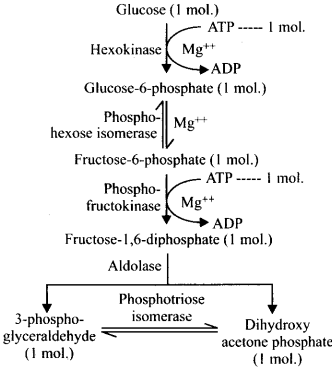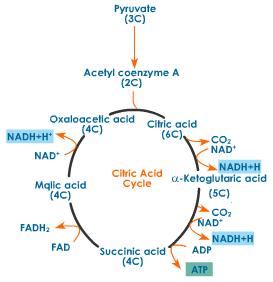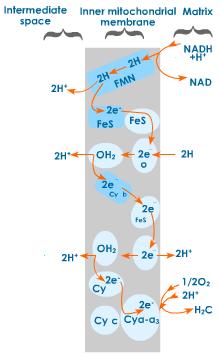Respiration in Plants - Solutions
CBSE Class 11 Biology
NCERT Solutions
Chapter 14
Respiration plants
1. Differentiate between
(a) Respiration and Combustion
(b) Glycolysis and Krebs’ cycle
(c) Aerobic respiration and Fermentation
Ans. (a) Respiration and combustion
Respiration | Combustion |
1. It is a biochemical process. | 1. It is a physicochemical process. |
(b) Glycolysis and Kreb's cycle:
Glycolysis | Kreb's cycle |
1. It occurs inside the cytoplasm. | 1. It operates inside the mitochondria. |
(c) Aerobic respiration and Fermentation:
Aerobic respiration | Fermentation |
1. It involves the exchange of gases. | 1. It does not involve the exchange of gases. |
2. What are respiratory substrates? Name the most common respiratory substrate.
Ans. The compounds oxidised during the process of respiration are called respiratory substrates. Carbohydrates, especially glucose, act as respiratory substrates. Fats, proteins, and organic acids also act as respiratory substrates.
3. Give the schematic representation of glycolysis?
Ans.

4. What are the main steps in aerobic respiration? Where does it take place?
Ans. Thefollowing are themain steps in aerobic respiration:
- Glycolysis: It is the breakdown of glucose to pyruvic acid and occurs inside the cytosol of cytoplasm.
- Oxidative decarboxylation of pyruvic acid to acetyl coenzyme-A: It occurs inside the mitochondrial matrix.
- Tricarboxylic acid cycle or Kreb's cycle: It occurs inside the mitochondrial matrix.
- Electron transport system and oxidative phosphorylation which occur in the inner mitochondrial membrane involving ATP synthase complex.
Aerobic respiration occurs in mitochondria.
5. Give the schematic representation of an overall view of Krebs cycle.
Ans.

6. Explain ETS.
Ans. ETS or electron transport system is located in the inner mitochondrial membrane. It helps in releasing and utilizing the energy stored in NADH+ and FADH2. NADH + H+, which is formed during glycolysis and citric acid cycle, gets oxidized by NADH dehydrogenase (complex I). The electrons so generated get transferred to ubiquinone through FMN. In a similar manner, FADH2 (complex II) generated during citric acid cycle gets transferred to ubiquinone. The electrons from ubiquinone are received by cytochrome bc1 (complex III) and further get transferred to cytochrome c. The cytochrome c acts as a mobile carrier between complex III and cytochrome c oxidase complex, containing cytochrome a and a3, along with copper centres (complex IV). During the transfer of electrons from each complex, the process is accompanied by the production of ATP from ADP and inorganic phosphate by the action ATP synthase (complex V). The amount of ATP produced depends on the molecule, which has been oxidized. 2 ATP molecules are produced by the oxidation of one molecule of NADH. One molecule of FADH2, on oxidation, gives 3 ATP molecules.

7. Distinguish between the following:
(a) Aerobic respiration and Anaerobic respiration
(b) Glycolysis and Fermentation
(c) Glycolysis and Citric acid Cycle
Ans. (a) Aerobic respiration and Anaerobic respiration:
Aerobic respiration | Anaerobic respiration |
|
|
(b) Glycolysis and Fermentation:
| Glycolysis | Fermentation |
a.It is the process of converting glucose into pyruvic acid b. No ATP is released during this proces. c. End product is pyruvic acid. | a.It is the process of breaking down of glucose into ethanol and carbondioxide. b. ATP is released in this process. c. End product is ethanol and carbon dioxide. |
(c) Glycolysis and Citric acid cycle
Glycolysis | Citric acid cycle |
a. It occurs inside the cytoplasm. b. It is a straight or linear pathway. c. It is the first step of respiration in which glucose is broken down to the level of pyruvate. d. The net gain of energy is equal to 8 ATP. | a. It operates inside the mitochondria. b. It is a cyclic pathway. c. .It is the second step in respiration where an active acetyl group is broken down completely. d. The net gain of energy is equal to 24 molecules of ATP. |
8. What are the assumptions made during the calculation of net gain of ATP?
Ans. For theoretical calculation of ATP molecules, various assumptions are made, which are as follows.
(a) It is assumed that various parts of aerobic respiration such as glycolysis, TCA cycle, and ETS occur in a sequential and orderly pathway.
(b) NADH produced during the process of glycolysis enters into mitochondria to undergo oxidative phosphorylation.
(c) Glucose molecule is assumed to be the only substrate while it is assumed that no other molecule enters the pathway at intermediate stages.
(d) The intermediates produced during respiration are not utilized in any other process.
9. Discuss “The respiratory pathway is an amphibolic pathway.”
Ans. Respiration is generally assumed to be a catabolic process because during respiration, various substrates are broken down for deriving energy. Carbohydrates are broken down to glucose before entering respiratory pathways. Fats get converted into fatty acids and glycerol whereas fatty acids get converted into acetyl CoA before
entering the respiration. In a similar manner, proteins are converted into amino acids, which enter respiration after deamination. During synthesis of fatty acids, acetyl CoA is withdrawn from respiratory pathway. Also, in the synthesis of proteins, respiratory substrates get withdrawn. Thus, respiration is also involved in anabolism. Therefore, respiration can be termed as amphibolic pathway as it involves both anabolism and catabolism.
10. Define RQ. What is its value for fats?
Ans. Respiratory quotient (RQ) or respiratory ratio can be defined as the ratio of the volume of CO2 evolved to the volume of O2 consumed during respiration. The value of respiratory quotient depends on the type of respiratory substrate. Its value is one for carbohydrates. However, it is always less than one for fats as fats consume more oxygen for respiration than carbohydrates. It can be illustrated through the example of tripalmitin fatty acid, which consumes 145 molecules of O2 for respiration while 102 molecules of CO2 are evolved. The RQ value for tripalmitin is 0.7.
11. What is oxidative phosphorylation?
Ans. Oxidative phosphorylation is a process in which electrons are transferred from electron donors to oxygen, which acts as electron acceptor. The oxidation-reduction reactions are involved in the formation of proton gradient. The main role in oxidative phosphorylation is played by the enzyme ATP synthase (complex V). This enzyme
complex consists of F0 and F1 components. The F1 headpiece is a peripheral membrane protein complex and contains the site for ATP synthesis from ADP and inorganic phosphate. F0 component is a part of membrane protein complex, which acts as a channel for crossing of the protons from inner mitochondrial membrane to the mitochondrial matrix. For every two protons passing through F0–F1 complex, synthesis of one ATP molecule takes place.
12. What is the significance of step-wise release of energy in respiration?
Ans. The process of aerobic respiration is divided into four phases – glycolysis, TCA cycle, ETS, and oxidative phosphorylation. It is generally assumed that the process of respiration and production of ATP in each phase takes place in a step-wise manner. The product of one pathway forms the substrate of the other pathway. Various molecules produced during respiration are involved in other biochemical processes. The respiratory substrates enter and withdraw from pathway on necessity. ATP gets utilized wherever required and enzymatic rates are generally controlled. Thus, the step-wise release of energy makes the system more efficient in extracting and storing energy.